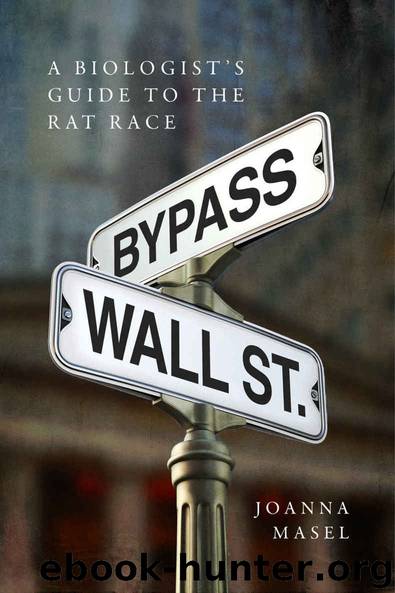Bypass Wall Street: A Biologist's Guide to the Rat Race by Joanna Masel

Author:Joanna Masel [Masel, Joanna]
Language: eng
Format: epub
Publisher: Perforce Publishing, LLC
Published: 2016-02-01T06:00:00+00:00
CHAPTER 15
PUBLIC VERSUS
PRIVATE INVESTMENT
Using our magic glasses, we have looked for things that we as a society could do today that would pay us back later with interest. We found some good options. Through our government, we can put in place new incentive structures such as carbon taxes, harnessing market forces to drive the preservation of wealth in the form of natural resources. We can invest more in the maintenance and improvement of public physical infrastructure such as roads, bridges, sewers, levees, etc., paying for these investments either through increased taxes today, or through bonds that savers like Jen can buy, to be paid back through increased taxes later. We can raise this money, whether now or later, by taxing the rich; when all rich people are hit equally, this de-escalates arms races to consume things that are newer, larger, and more fashionable than one’s competitors. Because these positional battles for status are relative not absolute, damping their excesses does no damage to people’s welfare. We can fund comparative effectiveness research to create knowledge about how to provide better healthcare at lower cost. And I have hinted that the biggest potential gains of all may be in human capital, which could (let’s wait and see as this book continues) involve increased public investment in education.
On the basis of this list, you are probably thinking by now that I am a died-in-the-wool leftist. For every problem, I see government intervention as the solution. My investment priorities involve new carbon taxes, more redistribution, and increased government spending on public infrastructure and medical research.
In fact, I am a big fan of competitive markets. When they work, they work spectacularly well. Maybe the problem, in a perverse way, is that markets work too well in such cases. They have worked so well, for so long, that the low-hanging fruit has already been taken. If the private sector really did have good, not yet funded ideas about how to invest in the future, then there is no shortage of savers like Jen out there, keen to lend the money. If you are a large company and have a great idea for creating wealth, you can already borrow money at an extraordinarily low interest rate through bond markets. And Jen can lend you that money through her retirement account. The problem is a shortage of borrowers with access to the bond market and with good ideas about how to put money to good use, even at these low interest rates.
The conventional economics answer is that to find borrowers, interest rates need to go even lower. To get out of our current liquidity trap and increase investment, real interest rates need to be negative, i.e. lower than inflation. The only way to get there is to have higher inflation. This is not a happy scenario. Saving money today so that we can get less purchasing power back later is a terrible way to prepare for retirement.
Government handouts to companies are not the answer. They may keep companies afloat, but they don’t increase the rate of return on the companies’ investments.
Download
This site does not store any files on its server. We only index and link to content provided by other sites. Please contact the content providers to delete copyright contents if any and email us, we'll remove relevant links or contents immediately.
International Integration of the Brazilian Economy by Elias C. Grivoyannis(91289)
The Radium Girls by Kate Moore(11921)
Turbulence by E. J. Noyes(7936)
Nudge - Improving Decisions about Health, Wealth, and Happiness by Thaler Sunstein(7615)
The Black Swan by Nassim Nicholas Taleb(7010)
Rich Dad Poor Dad by Robert T. Kiyosaki(6405)
Pioneering Portfolio Management by David F. Swensen(6226)
Man-made Catastrophes and Risk Information Concealment by Dmitry Chernov & Didier Sornette(5921)
Zero to One by Peter Thiel(5686)
Secrecy World by Jake Bernstein(4646)
Millionaire: The Philanderer, Gambler, and Duelist Who Invented Modern Finance by Janet Gleeson(4376)
The Age of Surveillance Capitalism by Shoshana Zuboff(4210)
Skin in the Game by Nassim Nicholas Taleb(4162)
Bullshit Jobs by David Graeber(4095)
The Money Culture by Michael Lewis(4076)
Skin in the Game: Hidden Asymmetries in Daily Life by Nassim Nicholas Taleb(3929)
The Dhandho Investor by Mohnish Pabrai(3699)
The Wisdom of Finance by Mihir Desai(3654)
Blockchain Basics by Daniel Drescher(3507)
